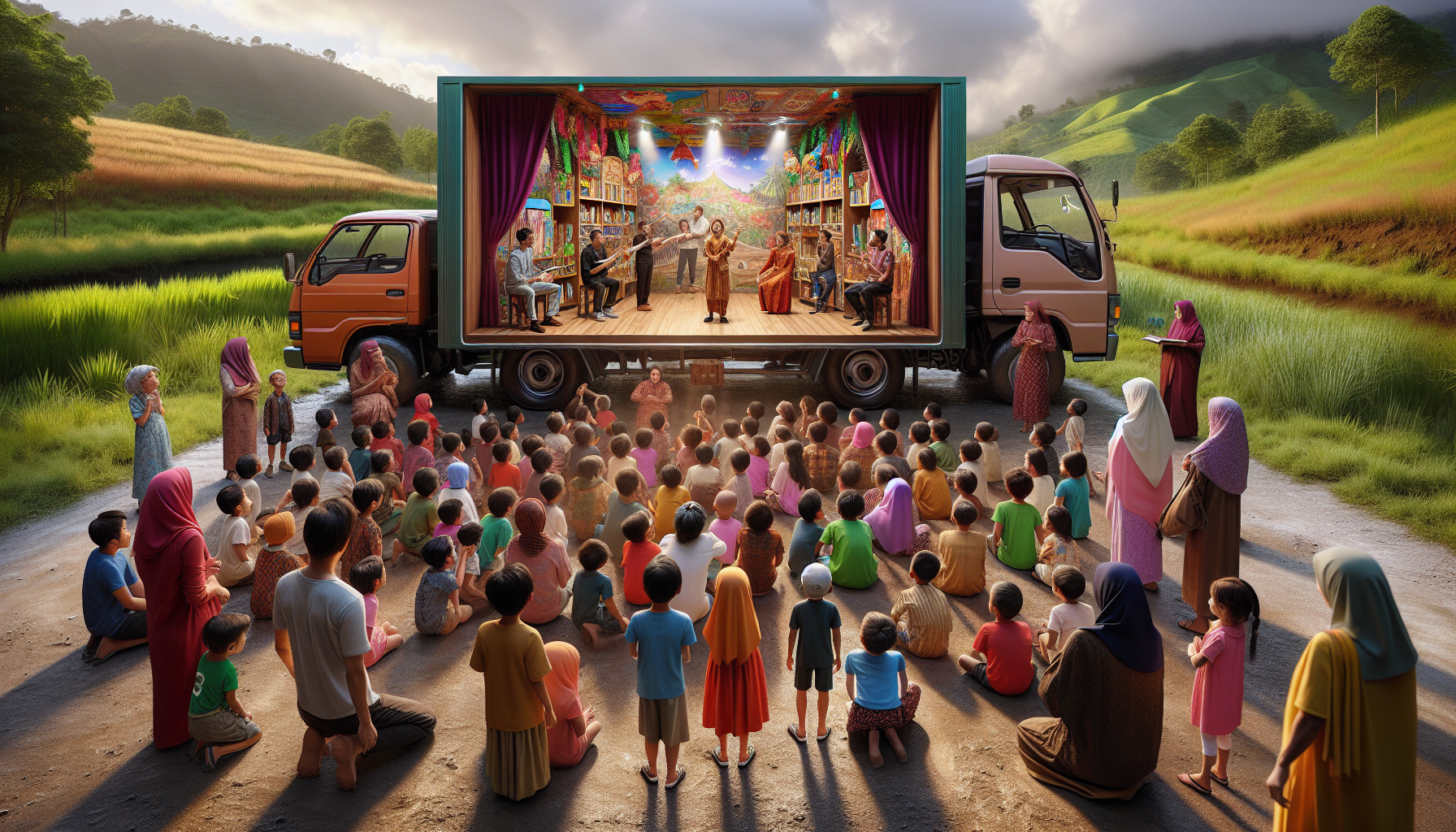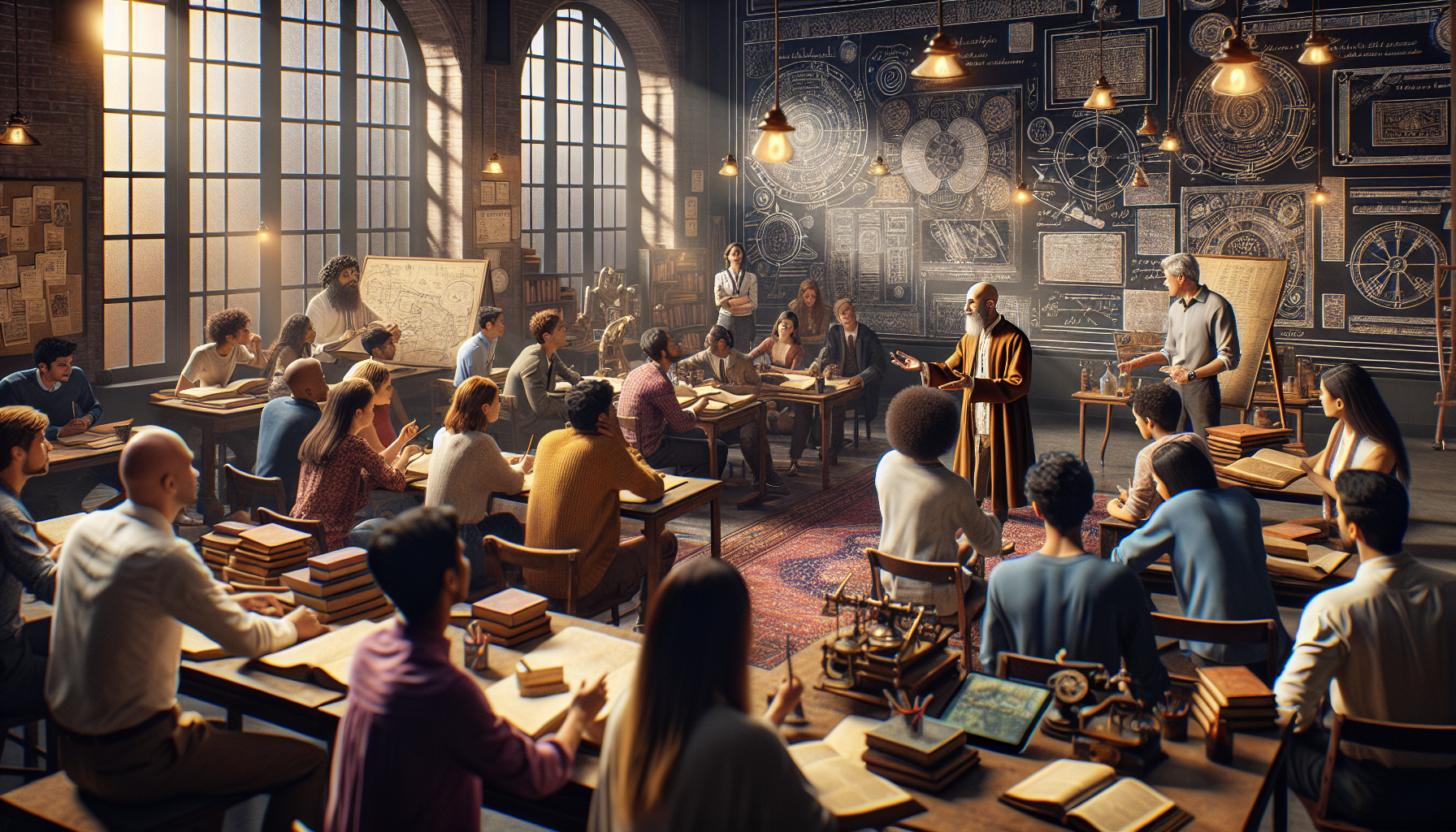In a world where technology increasingly shapes the landscape of education, finding innovative ways to engage learners and spark creativity is more important than ever. Imagine a classroom without walls, where the world itself becomes a stage and learning is an immersive, mobile experience. Welcome to the realm of Mobile Literacy Theater—a dynamic, transformative approach that is redefining how we perceive education and engagement. 🌟
At the heart of this innovative concept lies the idea of harnessing the power of storytelling and performance to ignite the imagination and foster a deeper connection to learning. Unlike traditional methods confined within four walls, Mobile Literacy Theater takes education on the road, bringing vibrant, interactive performances directly to students and communities. This approach is not just about entertainment; it’s about creating a unique learning experience that encourages participation, critical thinking, and a lifelong love of learning.
The roots of Mobile Literacy Theater can be traced back to the age-old tradition of storytelling, an intrinsic part of human culture that has been used for centuries to impart wisdom, share knowledge, and entertain. By merging this tradition with modern mobile technology, educators are able to reach broader audiences, breaking down geographical barriers and making learning accessible to all. This mobility allows for a more personalized and context-rich educational experience, where students can engage with content in a way that is relevant and meaningful to their own lives.
In this article, we will delve into the various facets of Mobile Literacy Theater, exploring how it is being implemented around the world and the profound impact it is having on education. We will examine the techniques used by educators and performers to craft compelling narratives that resonate with diverse audiences, and how these stories are used to address critical social issues, promote empathy, and encourage positive change. Additionally, we will look at the role of technology in enhancing these performances, and how it can be used to create a seamless blend of the physical and digital worlds.
Finally, we will explore the challenges and opportunities that come with adopting this unconventional approach to education. From logistical considerations to the need for creative collaboration, there are numerous factors that educators and communities must navigate to successfully implement Mobile Literacy Theater. However, the rewards are plentiful: an engaged, inspired audience; an enriched learning environment; and the cultivation of skills that will serve learners well beyond the classroom. Join us on this journey as we unlock the imagination and discover the limitless possibilities of learning on the road. 🚐✨
The Emergence of Mobile Literacy Theater
Mobile Literacy Theater has emerged as an innovative and engaging method of bringing educational content to diverse audiences. By taking learning outside the traditional classroom setting, this approach aims to inspire creativity, promote literacy, and make education more accessible. In an era where digital technology pervades every aspect of life, the fusion of theater and mobile technology offers a unique opportunity to unlock imagination and foster learning in novel ways.
The idea behind Mobile Literacy Theater is to utilize the portability of mobile technology combined with the immersive nature of theater to engage audiences in a dynamic learning experience. This approach has proven to be particularly effective in reaching communities that are often underserved by conventional educational resources. By literally taking the show on the road, educators and performers can bring stories and learning experiences directly to the people, breaking down barriers to access and participation.
Mobile Literacy Theater leverages various forms of media, including video, audio, and interactive elements, to create a multifaceted educational experience. This method encourages learners to actively participate in the storytelling process, fostering not only literacy skills but also critical thinking, creativity, and collaboration. By engaging multiple senses and offering diverse modes of interaction, Mobile Literacy Theater caters to a wide range of learning styles and preferences, making education both inclusive and enjoyable.
Key Components of Mobile Literacy Theater
Understanding the key components that make Mobile Literacy Theater effective is crucial for educators and organizations looking to implement this approach. Below, we explore the essential elements that contribute to its success and impact.
Interactive Storytelling
At the heart of Mobile Literacy Theater is interactive storytelling. This component involves creating narratives that invite audience participation and encourage learners to immerse themselves in the story. By using mobile technology, performers can incorporate elements such as choose-your-own-adventure scenarios, where audiences make decisions that influence the direction of the story. This interactive aspect not only engages learners but also helps develop their problem-solving and decision-making skills.
Technology Integration
Technology plays a critical role in Mobile Literacy Theater, providing the tools necessary to deliver content in a dynamic and engaging manner. Mobile devices such as tablets and smartphones are used to display digital content, while applications and software facilitate interactivity. Additionally, augmented reality (AR) and virtual reality (VR) can be integrated to create immersive environments that enhance the learning experience. The table below compares some of the key technologies used in Mobile Literacy Theater.
| Technology | Purpose | Benefits |
|---|---|---|
| Mobile Devices | Delivery of digital content | Portability, accessibility, ease of use |
| Augmented Reality (AR) | Immersive learning experiences | Enhanced engagement, interactive elements |
| Virtual Reality (VR) | Simulating environments | Full immersion, experiential learning |
Community Engagement
Community engagement is a fundamental aspect of Mobile Literacy Theater. By collaborating with local organizations, schools, and cultural institutions, theater groups can tailor their performances to reflect the unique needs and interests of the community. This collaboration helps build a sense of ownership and connection among audience members, increasing the likelihood of long-term engagement with educational content. Furthermore, community involvement can provide valuable feedback and insights that inform the development of future programs.
Challenges and Opportunities
While Mobile Literacy Theater offers numerous benefits, it also presents certain challenges that need to be addressed to maximize its effectiveness. Recognizing these challenges and exploring potential opportunities for growth and improvement is essential for sustaining the impact of this innovative approach.
Resource Limitations
One of the primary challenges facing Mobile Literacy Theater is resource limitations. Many organizations, particularly those operating in underserved areas, may lack the financial and technological resources necessary to implement mobile theater programs effectively. Addressing this challenge requires creative solutions, such as partnerships with technology companies or crowdfunding campaigns, to secure the necessary resources.
Moreover, performers and educators may need additional training to effectively utilize the technology and deliver content in a way that resonates with diverse audiences. Investing in professional development and capacity-building initiatives can help overcome these barriers, ensuring that practitioners are equipped with the skills and knowledge needed to deliver high-quality educational experiences.
Scalability
Scalability is another challenge that Mobile Literacy Theater must address. While mobile theater can have a significant impact at the local level, expanding these efforts to reach larger audiences requires careful planning and strategic partnerships. By leveraging networks of educators, artists, and community organizations, Mobile Literacy Theater can extend its reach and influence, bringing the benefits of this approach to more learners worldwide.
Furthermore, the use of digital platforms and online resources can facilitate the dissemination of content, making it accessible to a broader audience. By creating online repositories of educational materials and performances, organizations can ensure that their content remains available and relevant to learners across different contexts.
Opportunities for Innovation
Despite these challenges, Mobile Literacy Theater presents numerous opportunities for innovation and growth. As technology continues to evolve, new tools and platforms will emerge, offering even greater potential for creativity and engagement. For example, advancements in artificial intelligence (AI) could enable the development of more personalized and adaptive learning experiences, catering to the unique needs of individual learners.
Additionally, collaborations between theater practitioners, educators, and technologists can lead to the creation of innovative programs that push the boundaries of what is possible in educational theater. By fostering a culture of experimentation and collaboration, Mobile Literacy Theater can continue to evolve and adapt, remaining at the forefront of educational innovation.
Case Studies and Real-World Applications
Examining case studies and real-world applications of Mobile Literacy Theater provides valuable insights into how this approach can be effectively implemented and the impact it can have on learners and communities.
Case Study: The Storymobile Project
The Storymobile Project is a prime example of Mobile Literacy Theater in action. Developed by a nonprofit organization, this initiative brings storytelling and literacy activities to communities across the country. The project uses a specially designed vehicle equipped with digital technology and a portable stage to deliver interactive performances and workshops. Through partnerships with local schools and libraries, the Storymobile Project has reached thousands of learners, providing them with engaging and educational experiences that promote literacy and creativity.
Real-World Application: Digital Storytelling in Rural Areas
In rural areas with limited access to traditional educational resources, Mobile Literacy Theater has proven to be an effective tool for bridging the gap. By utilizing mobile technology and community partnerships, theater groups can deliver digital storytelling experiences that engage learners and promote literacy. One such example is a program that uses mobile devices and augmented reality to create interactive storytelling experiences in remote villages. This initiative not only provides access to educational content but also fosters a sense of community and cultural pride.
Watch the inspiring journey of the Storymobile Project in action: Mobile Literacy Theater: A New Educational Frontier
Lessons Learned
These case studies highlight several important lessons for organizations and educators looking to implement Mobile Literacy Theater. First, the importance of collaboration and partnership cannot be overstated. By working with local communities and organizations, theater groups can ensure that their programs are relevant and impactful. Second, the integration of technology must be carefully planned and executed to enhance, rather than detract from, the educational experience. Finally, ongoing evaluation and feedback are essential for continuous improvement and adaptation, ensuring that Mobile Literacy Theater remains effective and responsive to the needs of learners.
Conclusion
In conclusion, the concept of the Mobile Literacy Theater as explored in our discussion reveals a transformative approach to education that harnesses the power of creativity and mobility. This innovative initiative serves as a dynamic tool to engage and educate communities, particularly in under-resourced areas, by bringing literature to life through theatrical performances. By making learning both accessible and enjoyable, the Mobile Literacy Theater not only fosters literacy but also unlocks the imagination of its audiences, encouraging a lifelong love of reading and learning.
Throughout the article, we’ve examined the multiple layers of impact that this mobile theater can have. Firstly, we discussed how it addresses educational disparities by reaching children and adults in remote or underserved locations, where traditional educational resources may be limited. The mobility aspect ensures that learning opportunities are not confined to a specific location but are instead extended to a broader audience, creating equitable access to educational content.
Moreover, we delved into the methodology of integrating storytelling and performance as pedagogical tools. The use of theater to convey stories encourages active participation and engagement, making the learning experience memorable and impactful. This method stimulates cognitive and emotional connections to the material, enhancing comprehension and retention.
Another key point highlighted is the role of community involvement and collaboration. The Mobile Literacy Theater often involves local artists, educators, and volunteers, fostering a sense of community ownership and pride. This collaborative approach not only enriches the content but also ensures that the performances are culturally relevant and resonant with the audience.
Furthermore, the article shed light on the adaptability and sustainability of this educational model. By utilizing portable and cost-effective materials, the Mobile Literacy Theater can be easily replicated and adapted to various contexts and needs. This flexibility makes it a sustainable solution for ongoing educational challenges.
Importantly, we emphasized the broader societal impact of such initiatives. Beyond immediate educational benefits, the Mobile Literacy Theater promotes cultural exchange, social cohesion, and emotional well-being. By bringing diverse stories and perspectives to different communities, it fosters empathy, understanding, and a sense of global citizenship.
As we conclude, it is crucial to recognize the significance of initiatives like the Mobile Literacy Theater in shaping the future of education. In an era where digital technology often dominates the landscape, this approach reminds us of the enduring power of human connection, storytelling, and imagination. It challenges us to rethink traditional educational paradigms and consider more holistic and inclusive methods of teaching and learning.
We encourage you, dear reader, to reflect on the potential impact of the Mobile Literacy Theater within your own community or sphere of influence. Whether you are an educator, parent, artist, or simply a lover of stories, consider how you might support or participate in similar initiatives. Share this article with others who might be inspired by the possibilities of mobile literacy and theater, and join the conversation on how we can collectively enhance educational access and quality for all.
For further exploration and insights on mobile literacy and educational innovation, consider visiting these active resources:
1. Global Partnership for Education
2. UNESCO’s Literacy and Education Resources
Thank you for joining us on this inspiring journey. We look forward to hearing your thoughts and ideas!

Toni Santos is a visual storyteller and educational ethnographer whose work celebrates the fluid knowledge systems of nomadic cultures. Through art and research, Toni brings attention to how learning has thrived outside traditional institutions—rooted in movement, oral tradition, and deep connection to land and community.
Guided by a passion for ancestral wisdom, adaptive pedagogy, and cultural resilience, Toni explores the tools, rituals, and environments that once shaped the minds of travelers, herders, and migrating communities. Whether illustrating storytelling circles beneath open skies, wearable mnemonic devices, or maps woven into textiles, Toni’s work honors learning as a lived, sensory, and communal experience.
With a background in visual anthropology and intercultural design, Toni reconstructs the educational models of mobile societies through images and narratives that restore their dignity and relevance in today’s world.
As the creative mind behind Vizovex, Toni shares a rich tapestry of visual essays, artifact-inspired art, and curated stories that reveal the genius of teaching and learning on the move.
His work is a tribute to:
The wisdom of learning through journey, rhythm, and story
The spatial and environmental intelligence of nomadic cultures
The power of intergenerational knowledge passed outside walls
Whether you’re an educator, researcher, or lifelong learner, Toni invites you to step into a world where education is not confined, but carried—one step, one song, one shared insight at a time.





